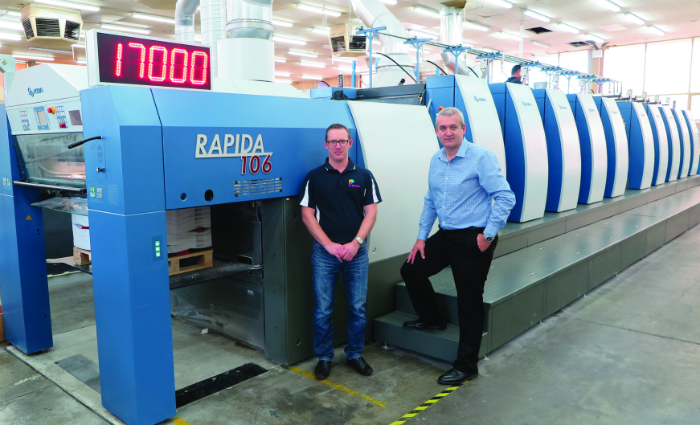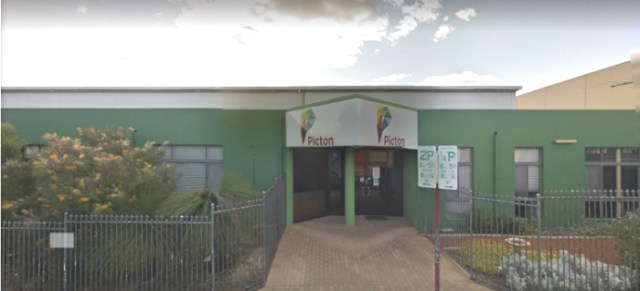
Two years ago Picton Press was in a situation far too common among decades-old printers that had not yet adjusted to the new realities of the printing industry where general commercial work is declining, prices are at all-time lows, and lean manufacturing is necessary for survival. It had a trio of slow, ageing offset presses pumping out mainly flyers, brochures, leaflets, and posters at less than optimal margins; bloated overheads from staff costs, rampant inefficiency, and stagnant business growth coming off a disappointing half year. Almost nothing was known about margins and profitability until the annual report and decisions were made on gut feel or trial and error and often wrong. Management knew things had to change for the company to thrive going forward, so it began a multimillion-dollar modernising project to become leaner, greener, and more automated.
Overhauling the kit
The first step was spending about $1m upgrading its digital kit to a Kodak Nexpress SX2700 and a Nexpress SX3900 with long-sheet feeder. Then in July 2013 Picton swapped out the MIS system it had used for a decade and replaced it with EFI Pace for a cost of $200,000, with the aim of making operations more efficient.
The biggest change of all was a massive overhaul of its offset presses. Its six-colour B1, five-colour B2 and 44-inch perfector were past their use-by date so they had to go. Instead of picking up some younger presses second hand, Picton invested millions for a new top-of-the-line ten-colour KBA Rapida 106 long perfector. General manager Graham Jamieson says replacing three presses with one might seem like a downgrade, but the machine is so effective that it actually has more capacity at faster speeds with lower costs. He says since being installed last June it is already well on its way to paying for itself in lower overheads and better performance.
“We never thought we would buy another new press but the efficiency gains are enormous,” he says. “It prints at 18,000 double-sided sheets an hour and the make-ready is down from 400- 500 a side on our old machines to 200 for both sides. What used to be a 24-hour job now only takes seven hours – we can put so much paper through in a shift it is incredible.”
Reliability was another big issue as the old presses frequently went down and needed repairs. With no other presses there is no fallback redundancy, but while Picton has trade printers it can call upon in an emergency, Jamieson it has never been down for more than a few hours. “The KBA is its own redundancy. Even if it were to go down for half a day it would catch up, it is so fast and reliable,” he says.
The Rapida 106 is coupled with a new Kodak Magnus CTP that is automated and fast enough to keep up with the high speed of the press. “The KBA is a make-ready king so it chews through the plate changes, so we needed to make plates faster,” he says. “With an automatic plate loader capable of holding 600 plates at a time and a speed of 45 plates an hour, it is just what we need to keep up with the thirst of the KBA for more plate changes.”
Automating everything
Jamieson says it is how all the parts of the investment program now work together that is the key to Picton’s transformation into a business in the best shape of its life, and that is well positioned for future challenges. “The ultimate goal for Picton is to have an efficient and highly automated workflow allowing us to focus on delivery of quality printed products and gives us even more ability to provide a solution to our customers, not just ink on paper,” he says.
All of Picton’s equipment is hooked up to the EFI Pace MIS for careful monitoring and complete end-to-end automation, making the process as efficient as possible and helping drive innovation and improvement. “This is a real-time, real-cost platform that gives us a better idea of where our business is at,” he says. “It is giving us a much better reporting system so we can make very educated decisions on our business. We do not have to go on gut feel anymore. The more you know about your business, the more data you have, the more profitable you can make it.”
The KBA is fitted with cameras that read colour on both sides of each and every sheet that allow the press to make its own adjustments on the fly. Jamieson says integration to Pace means all the information that the press operator needs to run a job is already entered into the press before he starts and an automated ink tracking system delivers the correct amount of ink to the ink ducts without the need for an operator to load them. “The way things are going in the industry, automation is a vital part of the future, and we’ve got to make sure we are as automated and up-to-date as possible,” he says.
Data services manager Brad Hall says setting the system up and learning how best to use it was a big task because few printers are doing pushing the technology as far as Picton is. “We had to evolve our technical skills to a higher level and take a step back from each part of the process to view it as a whole,” he says. “We had numerous people flowing in from EFI and KBA to help us and we were up all hours talking to them on the phone because the local operations do not have the expertise because no one is demanding it.”
Hall says as far as he knows he is the only JDF certified printer in WA and one of few in Australia. “We needed to bring the knowledge in-house because there is so much to it, everything in the business is driven through the MIS,” he says. “For example, online proofing makes the process smoother, quicker, and cheaper.”
Jamieson says automating everything through the MIS has had three measurable impacts on the business that have made it more efficient and dramatically reduced costs. First is faster turnaround on estimates as the team is able to use pre-built workflows as well as optimisation within Pace to quickly generate an estimate to client requirements. “Pace actually uses inbuilt intelligence to pick the best production method for the particular job, evaluating far more production methods that a human would be able to do in a reasonable time,” he says. Customer service staff can then give quicker answers to clients as they have instant access to information on a particular job. “Our staff will know what machine the job is on and when it is scheduled for dispatch. No more guessing,” he says. Clients can also keep track of the progress of their order and are notified when it has been dispatched. Some of our customers have also had custom workflows and online portals built to meet their specific needs.
Unlocking new business areas
Picton’s new equipment has also opened up new markets that are more profitable than the commoditised commercial printing it was focused on before. While general commercial work is still a big part of its business it is magazines, catalogues, direct mail, and boutique packaging that now account for more than a third of Picton’s $12m turnover. Jamieson says 15-20 per cent of sales are magazines and catalogues, with the magazine business up 50-60 per cent from a year ago; and 20-25 per cent is direct mail, including several big food brands. “These are new markets for us that we had never been able to pursue before and did not do much of. Now we are aggressively attacking them,” he says. “We want to be the number one direct mail printer in WA.”
Digital has also greatly expanded, with the bigger Nextpress taking the load off the KBA for short run work that previously needed an A2 offset press. Operations manager Murray Scott says the cutoff point for switching to offset is quite high. “It is not uncommon for us to print 10,000 flyers in the digital room and that will keep rising. If we start getting enquiries for bulk runs of flyers at higher volumes, we switch it to offset,” he says. Jamieson says it also has excellent variable-data capabilities, either printed as the whole job is produced on digital or put through it after an offset run. “One of the major jobs they handle is a monthly order of about 200,000 leaflets for a nationwide entertainment chain, with each franchise requiring different products, prices and addresses on its brochures,” he says.
Picton now treats its digital operation as a separate business unit that makes up 15-18 per cent of turnover, producing mainly three-up A4 flyers, brochures, and presentation folders or booklets, often as print on demand. “Runs are getting shorter all the time, we are seeing lots of six-page A4 brochures with runs of up to 1000,” he says. Picton is looking at buying new digital finishing kit to further improve efficiency and keep up with growing demand.
Picton is also expanding its client base, with 10-15 per cent of work coming from the Eastern States, far away from its Perth base, and Jamieson says this is growing with increased demand from agencies and national and international brands impressed by the company’s new offering. It has also been coaxing back some work that has gone offshore, especially where publications customers are keen to restore the content flexibilities inherent in shorter lead times when printing in Australia.
Reaping the rewards
Jamieson says the quality, profitability, and efficiency improvements are immense and while turnover has stayed flat during WA’s recent downturn, the business is in the best market position it has ever been in with great potential for expansion ‘when the market turns good again’. Modern and efficient operations have not only slashed the cost of repairs, maintenance, waste, raw materials, and makeready, they also mean the company can do more work with less staff. Picton now only runs two shifts instead of three and has let its head count fall 20 people to its current 33 from natural attrition. “Some people were not up to the challenge of learning to do things differently and left, but most of the production staff have stayed with us,” Jamieson says.
Picton has also trained staff on multiple applications so they can work on more areas of the business, and be more efficient at their jobs from better training. “We want to be a low-cost producer through technology-driven efficiencies,” he says. “Everyone wants a good price but we need to make a healthy profit and keep the business growing, so we have lowered our cost base through lean manufacturing and passed savings onto our clients. Adding value to our work and entering new, high-value markets have made us more competitive and are improving our profitability and bringing in new work.”
Overall, Jamieson says the management team is very happy with how it is going and feel transforming the business is one of the best opportunities they have ever taken advantage of. “There has been a lot of pain, and I am glad were are on this side of it not the other,” he says. “Some upgrades change the way you use technology, and make it impossible to go back to the inferior choice. High-end quality print is something you don’t think you need until you have been spoilt. Not only are you likely to find it is better priced due to the efficiency, but the quality is unlike anything you have seen before — and you’ll never be able to go back to those old outdated presses, producing low quality colour reproduction. The difference is like listening to an old 78 record played on a hand cranked record player compared to the high definition digital music of today.”
Comment below to have your say on this story.
If you have a news story or tip-off, get in touch at editorial@sprinter.com.au.
Sign up to the Sprinter newsletter



